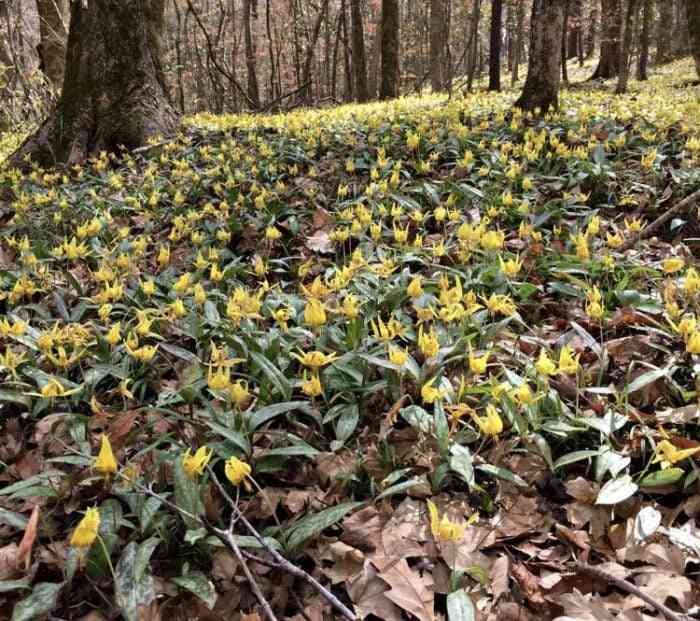Your cart is currently empty!
Trout Lily: Photogenic and Useful
Photo:
Katja Schulz from Washington, D. C., USA, CC BY 2.0 via Wikimedia Commons
Trout lily, a plant with stunning yellow flowers that bloom in the early spring, is quite photogenic. Large colonies of trout lilies can entirely blanket the forest floor as they mature. The colonies take a very long time to grow to this magnitude and can be hundreds of years old.
Naturalize in moist soils in shaded areas of native plant gardens, shade gardens, woodland gardens or wild/naturalized areas. Also grows well in pond or stream banks or in shady areas of rock gardens.
Quick Growing Guide

Botanical Name: Erythronium americanum
En français: Érythrone d’Amérique
See More Plants in this Botanical Family:
Colour:
Blooms:
Sun / Shade:
Water: Medium water required
Soil:
Pollinators:
Care:
According to legend, the Trout Lily’s speckled leaves look like the patterns on trout. The majority of populations are predominately composed of non-flowering individuals. The Cherokee used to crush the warmed leaves and then applied the juice to open wounds.

Growing Trout Lily
It is ideal for planting trout lilies in areas where they can grow naturally. Plant them 2 to 4 inches apart, and 5 inches deep for a colony look. Avoid damaging the offset corms that grow when weeding around it because they are the seed for new plants.
Trout lily has a good relationship with ants. They distribute the seeds and aid the plant in naturalizing—many ants in or around the plants is a positive sign. Leave the foliage in situ as a natural mulch throughout the winter once it dies back in the summer.
Light
An east-facing site with morning sun is ideal for cultivating trout lilies. Trout lily naturally grows beneath deciduous trees like oaks and maples in its natural habitat. This location offers plenty of sunlight in the early spring before the trees have finished shedding their leaves, which the plants require to flourish and bloom. Later, a perfect location provided summertime dappled shadow to
shield the plant from the scorching midday and afternoon sun.
Soil
Any humus-rich, light, wet soil, like the soil in its natural habitat, is suitable for growing trout lilies. Dense garden soils need to be heavily modified with peat moss or compost to provide the appropriate atmosphere. Acidic soil should have a pH of less than 6.
Water
During the plant’s spring growing season, it requires moisture, roughly 1 inch of rain, or irrigation-provided water each week. After entering dormancy in the summer, trout lily needs drier circumstances and doesn’t require watering.
Temperature and Humidity
In hardiness zones 3 to 8, yellow trout lilies can survive temperatures as low as minus 30 degrees Fahrenheit. This plant, which is a native of woodlands and wet meadows, can withstand humidity but cannot withstand extremely hot, dry weather.
Fertilizer
If this plant is put in rich, humus-rich soil, it won’t require additional fertilizer. Instead, add more organic matter to the top dressing each spring before the commencement of new growth.
Features
USDA zones 3-9 are ideal for growing trout lilies. Cut the bell-shaped, downward-facing blossoms, and bring them inside to use in a vase or an arrangement. With their spectacular blossoms of yellow or white in the early spring, these amazing plants, when left undisturbed, can develop clusters or colonies on their own and are guaranteed to make a fabulous prospect for your garden.
This plant is a terrific option if you need a ground cover for regions that get a lot of shade or if you have low-light areas that you want to brighten up with some color in the spring.
One of this beauty’s best qualities is that it typically blooms earlier than most other perennials, and even when it is not in full spring bloom, during the summer and fall seasons, this plant’s mottled leaves are beautiful in their own way.
Growing From Seed
Cultivating yellow trout lilies from seeds can take up to five or six years to produce mature flowering plants. Thus, it’s rarely done except by hybridizers and highly serious amateur experimenters. However, you can direct sow seeds just as the seed capsules split in the summer if you have enough area to grow a colony of yellow trout lilies.
No seedlings will be visible during the first season, but you’ll probably notice the grass-like seedlings emerging the following spring. But it will take the plants at least two years to become recognized and another two to three years for the plants to bloom.
Are Trout Lily edible?
Both a medicinal and culinary plant, trout lily. The blooms are slightly caustic and have a small sweetness from their nectar, while the leaves have a very faint flavor. The edible corms, which taste like cucumbers, are also edible.
It is advised against consuming a lot of trout lilies in one sitting because they are emetic (cause nausea and vomiting). You can eat this plant as a trail snack or add it to a salad. Flowers, leaves, or corm can all be used to brew tea.
Habitat
Only woods in eastern Canada and the United States support the growth of trout lilies. They can also be found in a few forested locations in Asia and Europe.
Share with Family and Friends
Featured Authors
Visit a Botanical Garden For Unique Experiences.
Comments
Logging in to comment gives you more features, but it is not required.
Subscribe
0 Comments
Oldest












